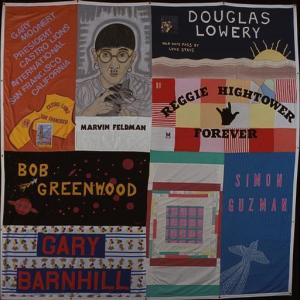Digitizing the NAMES Project Memorial Quilt

This summer, the panels that comprise the NAMES Project AIDS Memorial Quilt will be on display in Washington, D.C. To make this possible, volunteers working will be creating more than 60 distinct displays over the course of 31 days in more than 50 locations throughout the Capital region. The NAMES Project AIDS Memorial Quilt is, as of 2010, the largest piece of community folk art in the world. Consisting of 48,000 panels and weighing in at more than 57 tons, the AIDS Memorial Quilt (as it has come to be known) commemorates more than 91,000 names. In addition to its weight, the physical quilt measures more than 1.3 million square feet and covers more than 29 acres of land. It would take a visitor more than 33 days to view every panel—spending only one minute at each panel. It is the largest living memorial of its kind in the world, and it was officially designated an American treasure in 2005.
For some background information on the quilt's origins, "The idea for the NAMES Project Memorial Quilt was conceived in 1985 by AIDS activist Cleve Jones during the candlelight march in remembrance of the 1978 assassinations of San Francisco Supervisor Harvey Milk and Mayor George Moscone. For the march, Jones had people write the names of loved ones that were lost to AIDS-related causes on signs that would be taped to the San Francisco Federal Building. All the signs taped to the building looked like an enormous patchwork quilt to Jones, and he was inspired. It officially started in 1987 in San Francisco...At that time many people who died of AIDS-related causes did not receive funerals, due to both the social stigma of AIDS felt by surviving family members and the outright refusal by many funeral homes and cemeteries to handle the deceased's remains. Lacking a memorial service or grave site, The Quilt was often the only opportunity survivors had to remember and celebrate their loved ones' lives. The first showing of the The Quilt was 1987 on the National Mall in Washington, DC."
If you happen to be in Washington, D.C., you can go to the Quilt 2012 website and find out where to see the various exhibits.
A new initiative between The University of Iowa Digital Studio for Public Humanities (DSPH); Professor Anne Balsamo and researcher Dale MacDonald at the University of Southern California Annenberg Innovation Lab, and the NAMES Project has launched AIDS Quilt Touch, a mobile web application that will allow visitors to Washington, D.C., to locate a specific panel when it is laid out on the National Mall.
If, like me, you aren't going to be in D.C. this summer, you are in luck! The app will also allow people like us to view panels of the quilt, to leave remembrances, and contribute comments to a digital guest book.
Though this AIDS Quilt Touch was designed in conjunction with this summer's events, it will continue to be a tool for both scholars and interested individuals. After the Quilt 2012 events, the app will continue to serve as a portal that enables people to browse the entire collection of quilt panels, read the stories of the quilt, trace the travels of any single panel, and participate in crowd sourcing information about individual panels. Jon Winet, DSPH director and associate professor of intermedia in the School of Art and Art History in the College of Liberal Arts and Sciences explains, “The aim is not to replace or interfere with the experience of viewing the textile quilt, but to augment that experience and to extend the opportunity to view the quilt to people all over the world through online access.”
Users at the app's webpage are given options for searching the quilt. They can access it by panel block number (the image attached to this blog entry is panel #1) or by name. Either search will pull up an image of the panel in question and the option to find out where and when it will be exhibited. Additionally, users are given the option to share their thoughts on the quilt by clicking on a "share your thoughts" option. Users are encouraged to both leave behind thoughts and to read other people's.
As AIDS Quilt Touch grows and matures (and here's hoping it does both), there are any number of things that can be enlarged and embellished. It is, after all, a mobile web app still technically in the development stage. I don't know what the next update (scheduled for 20.July) will entail, but I do hope they creators add bio information to the quilt names, memories from their loved ones and panel makers, and, if possible, info about the panel makers themselves.
Regardless, however, this app is both informative and, in its own way, a digital extension of the The NAMES Project AIDS Memorial Quilt's ethos. It will provide untold numbers of people access to the quilt, and it will, as the quilt does, act as a storehouse of the thoughts, memories, messages, and wishes of those who come to it and add to it.
In its way, AIDS Quilt Touch represents a digital extension of both community folk art and memorial.